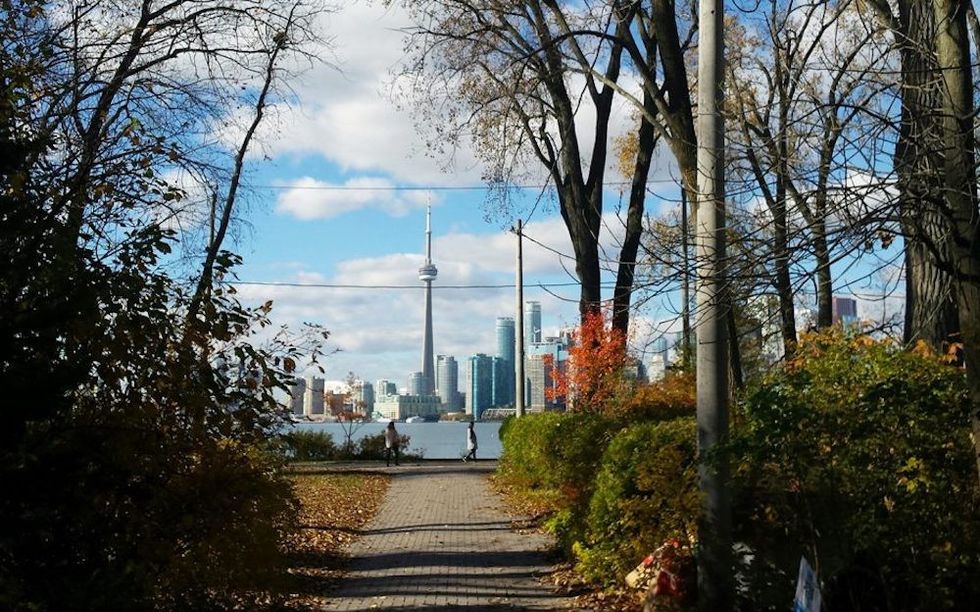A scenic ferry ride has always been a quintessential part of a trip to the Toronto Islands.
It’s been that way since the first commercial ferries hit Lake Ontario back in 1833.
But -- at a time of rapidly increasing density and limited urban green space -- does it make sense to build a bridge to the beloved Islands? One Toronto City Council candidate thinks so.
City Council hopeful April Engelberg (Spadina-Fort York) took to Twitter yesterday to announce that she wants to build a lift bridge that would connect Toronto’s rapidly transforming Port Lands to the Islands. Engelberg is advocating for the construction of a 250-metre bridge for pedestrians and cyclists that would cross the Eastern Channel and connect Ward’s Island to the Port Lands.
She calls the city’s existing ferry system “slow, expensive, and outdated.” And she's not wrong. A roundtrip ferry ride currently costs $8.70 (a tab that adds up for a family outing) and takes about 15 minutes. But the whole experience is also often characterized by frustrating wait times and lineups on both end that can kinda kill that easy, breezy, island vibe.
Toronto-based urban planner Naama Blonder of Smart Density calls a bridge to the islands a “no brainer.” In fact, she says she can’t understand how it hasn’t been built already. Judging from personal experience, she says the ferries are currently inefficient when it comes to meeting demand.
“I visited the Toronto Islands last week, and thousands of people were waiting for the ferry,” says Blonder. “We missed one because there were so many people ahead of us; we just weren't let in and we waited with a group of toddlers and young babies for 40 minutes.”
It’s a Toronto tale most of us are familiar with -- and one that was exacerbated during the pandemic, when a collective craving for fresh air on the part of city residents was no match for capacity restrictions on the ferry fleet (or water taxis, for that matter).
“The pandemic really showed us the importance of parks when restaurants and other places to socialize closed,” Engelberg tells STOREYS. “Ninety-four percent of residents in Spadina-Fort York don't have a backyard, myself included. The Islands are more than 20 times the size of Trinity Bellwoods. It's time our ward's largest public park was free for everyone to access.”
The bridge would not only open up accessibility to the beloved islands, but also make getting there and back less of a headache thanks to shorter wait times. But is it viable, realistically? Or just a nice idea in theory?
“I know having free, uninterrupted access for the boats is the issue that prevented us from having a bridge in the past, so the lift idea is probably a good one,” says Blonder. “But God is in the details; we need to make sure it’s well designed and that we’re not replacing our waiting time for the ferry with a waiting time for the lift. We need to ensure that the bridge has proper capacity and is also designed in a pleasant way that enhances the character of the waterfront and the public realm.”
There’s also the concern that the bridge will potentially take away much-needed revenue generated by the ferries at a time when the City needs all the cash it can get with respect to its pandemic recovery. “We will need to consult with the residents of the Toronto Islands regarding an updated ferry schedule,” says Engelberg. "There will always be a need for ferries to the islands and I know many Torontonians have fond memories of riding them.”
As for the fate of the ferries, the City has a plan to replace the existing boats with an all-electric fleet in the next 15 years -- a move that will not only speed up transport times but is better for the environment. The Toronto Island Park is currently served by a ferry fleet of four primary vessels and one heritage vessel, which together transport over 1.4M passengers and 5,000 vehicles annually to Toronto’s largest park. Although well-maintained and undoubtedly charming, the vessels are between 50 to 100 years old, well beyond the industry average lifespan for similar ferries.
So, in January, the City of Toronto submitted a report that recommends a plan to replace four existing primary ferries over a 15-year period. The initial ferry replacement strategy proposed a hybrid diesel-electric technology. But, with Ontario's population expected to surge by 30% in just over 20 years, perhaps a bridge wouldn't hurt either.
Engelberg’s big idea was met with a mixed reaction from the social media jury. While some praised it as “thinking outside the box,” "fresh," and "bold," others weren’t exactly fans. Mainly, they wouldn’t exactly call it a “priority” like Engelberg did. A few users weighed in that the City shouldn’t tackle an island bridge until it deals with its affordable housing crisis. “What a waste of money,” wrote one.
"The Islands are already overrun by visitors, with environmental impacts degrading the very qualities that make it special," wrote another. "Instead, Toronto needs more top-tier recreation facilities *outside* downtown, starting with converting its five civic golf courses, many in priority 'hoods."
Of course, the materialization of the proposed bridge requires many moving parts and logistics -- so the opponents don't have to worry about it happening any time soon.
“Any infrastructure project requires collaborative stakeholder consultation to make sure that everyone has a chance to participate in the process; I know it's possible to create a version of this bridge that serves the interests of both island residents and mainlanders,” says Engelberg. “We'll also need to engage the province and federal government as partners to execute on this project. Another important consideration is preserving access to shipping in Ports Toronto. That's why I am proposing a lift bridge, so that the large cargo ships can pass through.”






















